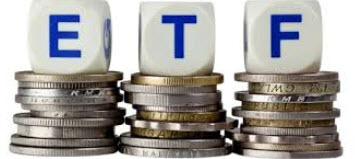An Exchange Traded Fund (ETF) is a marketable security that, unlike mutual funds, trades like a common stock on a stock exchange. This makes it very easy to buy and sell EFT shares.
An ETF can track an index, shares of stock, commodities, bonds, futures, foreign currency, and more. There are even ETFs that track other ETFs.
 Compared to mutual fund shares, ETFs tend to have lower fees and higher daily liquidity. On each trading day, the ETF can go through price changes. While mutual funds have their net asset value (NAV) calculated once a day at the end of the trading day, this is not the case for ETFs.
Compared to mutual fund shares, ETFs tend to have lower fees and higher daily liquidity. On each trading day, the ETF can go through price changes. While mutual funds have their net asset value (NAV) calculated once a day at the end of the trading day, this is not the case for ETFs.
Before investing in an ETF, it is important to know that the investment vehicle structure can vary from one EFT to another, and that several EFT structures can be legal within the same jurisdiction.
When you become an ETF shareholder, you do not get any direct claim to any underlying investments. You own shares of the ETF, you do not directly own any asset purchased by the ETF. As a shareholder, you are entitled to a proportion of the profits. You may also be paid residual value if the ETF is liquidated.
Examples of well-known and highly liquid EFTs
| Symbol | Name |
| SPY | SPDR S&P 500 ETF |
| GDX | VanEck Vectors Gold Miners ETF |
| EEM | iShares MSCI Emerging Markets ETF |
| XLF | Financial Select Sector SPDR Fund |
| EWJ | iShares MSCI Japan ETF |
| XIV | VelocityShares Daily Inverse VIX Short-Term ETN |
| DUST | Direxion Daily Gold Miners Index Bear 3x Shares ETF |
| IWM | iShares Russell 2000 ETF |
| EFA | iShares MSCI EAFE ETF |
| USO | United States Oil Fund |
| QQQ | PowerShares QQQ ETF |
| FXI | iShares China Large-Cap ETF |
A few examples of why EFTs are popular
- An easy way of achieving investment diversification
- You can purchase as little as one share.
- No minimum deposit requirements
- Can be shorted and bought on margin
- Can help an investor fight the bias to the upside. There are EFTs designed for both bull and bear markets.
- Many ETFs available have a very low expense ratio, considerably lower than the typical expense ratio of an average mutual fund.
- When buying and selling ETF units, you pay your broker the same commission as for regular buy-and-sell orders.
- Capital gains from sales inside the fund are not passed through to shareholders. (This is a major difference between ETFs and mutual funds.) In some jurisdictions, ETFs can achieve a favourably taxed cash flow.
- An easy way to gain exposure to foreign stock markets. ETFs that track foreign stock market indices are available not just for well-established markets but for emerging markets as well, including markets on which it can be prohibitively complicated to invest in for the average individual investor.
- You can track an individual industry without actually having to invest in it and putting together your own diverse portfolio. For instance, you can invest in an ETF that tracks the oil, biotech, or energy industries.
Creation and redemption
Only authorized participants (APs), typically large financial institutions such as investment companies and banks, can create and redeem units of the ETF.
- Creation: When creation takes place, the AP will assemble the portfolio of underlying assets for the ETF. This basket will be handed over to the ETF and ETF units will be created for the AP.
- Redemption: When redemption takes place, the AP returns the ETF units to the fund and gets the basket of underlying assets back.
What is ETF arbitrage?
Since both the ETF and the underlying assets are tradeable, there are traders that focus on spotting arbitrage opportunities. Their trading ensures that the price of ETFs tend to stay at or near the fair value.
What is an inverse ETF?
An inverse ETF tracks he opposite return of the underlying asset or assets.
Example: An inverse Commodity ETF that tracks gold. For each 1% drop in the spot price of gold, the ETF gains by 1%.
What is a leveraged ETF?
An ETF can amplify the movements of the underlying assets through leverage or gearing.
Example: A 3x leveraged Commodity ETF that tracks gold. For each 1% increase in the spot price of gold, the ETF gains by 3%. For each 1% drop in the spot price of gold, the ETF drops by 3%.
Both normal and inverse ETFs can be leveraged.
This article was last updated on: June 1, 2024
